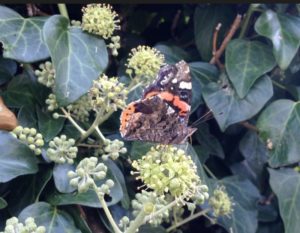One butterfly has completely stolen the show in Britain this year. Reported on New Year’s Day, coming second in the summer’s Big Butterfly Count and still gracing gardens in early November, the Red Admiral has had an exceptionally good year, possibly its best ever.
Strong, capable fliers, Red Admirals regularly undertake migratory journeys of hundreds of miles, typically in a northerly direction in spring/early summer and then southwards in the autumn. In this way, they track favourable climatic (and, therefore, vegetation) conditions that enable the Red Admiral to breed continuously throughout the year.
The impact of this lifestyle is clearly seen in the previous great Red Admiral years of recent decades, such as 1996 and 2003, when numbers of other migratory species such as the Painted Lady butterfly and Silver Y moth also soared.

But the causes of this year’s butterfly bonanza may be more complex. Over the past decade or so, rather than emigrating to warmer climes ahead of the first autumn frosts, Red Admirals have started to overwinter in Britain in large numbers, probably in response to climate change. We don’t yet know whether these butterflies are ones that have migrated here to spend the winter (just as Blackcap birds from Germany are increasingly doing) or ‘homegrown’ individuals that have simply stayed.
It does seem clear, however, that these tough insects do not enter a proper dormant state like our other overwintering butterflies (the Brimstone, Comma, Small Tortoiseshell and Peacock), but roost during bad weather and become active on sunny days right through the winter. As a result, nowadays, the Red Admiral is the most commonly seen butterfly in winter in the UK – quite a turnaround for a species that was hardly ever seen here in winter just a couple of decades ago! Breeding continues too, with territorial and courtship behaviour observed and developing caterpillars found throughout the winter.
In the past, with little or no overwintering here, the abundance of Red Admirals recorded in Britain in any one year bore no relation to that in the previous year. However, with Red Admirals now surviving our winters, we might expect knock-on effects from one year to the next as we see for resident butterfly species. The number of Red Admirals recorded in Britain during 2016 was high and the subsequent mild winter and spring may have benefitted their survival and enabled early breeding. Indeed, Butterfly Conservation received more reports of Red Admiral in January 2017 than of all other butterfly species put together, and numbers recorded on UK Butterfly Monitoring Scheme transects in spring and mid-summer were well above 2016 levels.
It’s too early to say whether 2017 will prove to be the best ever year for Red Admirals in the UK. But either way, keep a lookout for these impressive insects on ivy blossom, other late flowers or windfall fruit on sunny days this month.
Richard Fox Head of Recording, Butterfly Conservation
@RichardFoxBC Article can be found here
You can submit your sightings of Red Admirals or other butterflies to Butterfly Conservation via the free iRecord Butterflies app.


Recent Comments